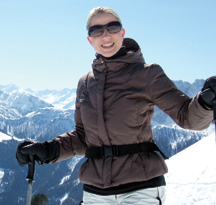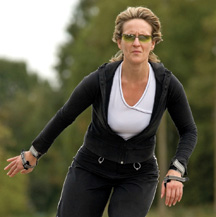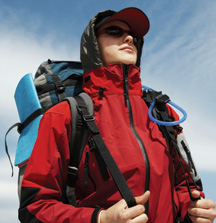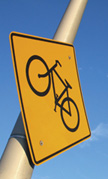 |
 |
 |
 |
| Photos from iStockphoto |
By Deirdre Carroll
Associate Editor
 |
 |
 |
 |
 |
| Photos from iStockphoto |
The OIF study also reported that more than three out of every four Americans participates in active outdoor recreation each year.
That means that in 2008 it is likely that more than three-quarters of the U.S. population will enjoy some form of biking, camping, fishing, hunting, hiking, wildlife-watching and water and snow sports in the great outdoors. And that number doesn’t even take into account the millions of additional Americans who will hit one of the country’s countless baseball diamonds, tennis courts and high school tracks, or want to at least look like they do.
But the best news of all is that most of them will be looking for eyewear that protects their vision and enhances their performance.
Vision Monday explored what these millions of people are looking for in their sport performance eyewear, what retailers and brands have a corner on the market and how the optical industry can bring home a bigger piece of this $730 billion pie.
We spoke to experts in the sporting goods and outdoor recreation markets and found that the number of consumers in this market is huge, they’re definitely looking for eyewear to enhance their performance and they are willing to spend whatever it takes to get it. VM learned there are many opportunities for ECPs to question their sport performance business and ways for them to sell more plano sunwear, and more prescription eyewear as a result.
Consumers as Avid Participants
Americans like their sports. According to the OIF’s 2006 Outdoor Recreation Participation Study, Americans ages 16 and older participated in a total of 3.6 different types of outdoor activities in 2005.
In fact, the Sporting Goods Manufacturer Association’s (SGMA), a trade organization representing the manufacturers of sporting goods, Insight07 Sports Participation in America study found that 77 percent of the U.S. population over the age six, 212 million people, participated in at least one sporting event in 2007.
“The growth of fitness has changed a lot in the last few years,” said T.J Kelly, vice president of marketing for Sportgenic, a San Francisco-based media and technology company that connects marketers to sport enthusiasts via more than 250 sports specific Web sites with more than 20 million unique users per month. “More Americans are involved in fitness related activities than they were in the 90’s. They’re more aware of the benefits of exercise and much of the growth is coming from middle-aged and older participants. Active consumers seemingly want to where the ‘badge’ of fitness now more than ever,” continued Kelly. And it is more than the weekend warriors and daily runners jumping on the bandwagon.
“The consumer in this market is everyone,” explained Larry Weindruch, director of communications for the National Sporting Goods Association (NSGA). “Children who play youth sports; teens who tend to set casual fashion trends by the sport-influenced clothing and shoes they wear; young adults and older teens who no longer play organized team sports but continue to stay active; adults who play in adult sport leagues and join health clubs; more mature adults who play golf, tennis and other lifetime sports; Baby Boomers, who are more into lower-impact fitness activities like exercise walking or cycling; and women, who in the last couple of decades have become much more active, especially in outdoor activities.”
As a matter of fact, Sportgenic segments their audience into as many as six specific categories that cover a broad spectrum of consumers. Adrenaline Junkies, ages 18 to 30 who participate in action sports like surfing and snowboarding; Country Clubbers, big spenders who play sports like golf and tennis and may be interested in yachts and equestrian sports; Endurance Athletes, who are passionate about long-distance sports; General Fitness Enthusiasts, social people concerned with general health and overall fitness; Outdoor Enthusiasts, environmentally conscious participants who enjoy activities such as kayaking trips or mountain bike rides; and Team Players, which includes families, league, team, club, junior and high school athletes, as well as mainstream sports fans.
Actually, according to Sportgenic’s own audience survey of 1,040 individuals in August 2007, specialized eyewear is the most likely league or team sports gear to be purchased in the next year with 24 percent of the respondents saying they would purchase it at least once.
Performance Eyewear in Demand
What’s more, Sportgenic’s survey found that 75 percent of respondents plan to buy specialized eyewear as part of their endurance sport gear purchases over the next year.
“As sports participants move up the ladder in terms of skills and amount of participation days, they also tend to look for products that help them improve their performance in that sport,” said Weindruch.
“Consumers definitely recognize a connection between their performance and their eyewear,” agreed Kelly. “Speaking from experience, the right eyewear is very important not only to your vision, but your safety. If you are bombing a single track on your mountain bike and something clouds your vision, you can really get hurt.”
“The casual sports participant may look more for the ‘cool look’ as opposed to high performance from their eyewear, but as you go farther up the performance ladder eyewear becomes more important,” continued Weindruch. “Skiing, cycling, running, hunting, fishing, hiking and canoeing/rafting are but a few of the sports where quality eye protection is important.”
And the NSGA, an organization that represent the interests of retailers and dealers who sell sporting goods products, has the sales figures to back up that claim. In their 2007 statistical study of retail sales in the sporting goods market, 19.3 million non-prescription sunglasses retailing for more than $10 were sold in 2006, raking in more than $750 million.
 What an Athlete Wants
What an Athlete Wants
And since they’re spending that kind of money, consumers definitely know what they want. “Product availability, price and staff expertise are all important to the consumer when shopping for performance eyewear,” stated Kelly.
“It’s both function and fashion to most of our consumers,” added Clint Wall, research manager for the Outdoor Industry Association (OIA), the parent organization to the OIF.
“People who participate in different types of activities have different needs. A fisherman, for example, would want polarized eyewear to reduce the reflection off the water,” added Weindruch. “Customers, in general, are looking for selection, quality and value. They don’t always go for the least expensive product, especially if it is from a specialty store that offers the kind of customer service that helps find the right product for the customer.”
In fact, price has less to do with a consumer’s decision than would be expected. The NSGA study determined the average price of non-prescription sunglasses retailing for more than $10 in 2006 to be $38.86, nearly $20 more than the national average of $19.60 for all plano sunglasses sold in the optical market in the same year, according to VisionWatch, a joint study by Jobson/VCA. Other factors rank as much more important than price to consumers looking to enhance their performance.
“Fit, weight, coverage of face and color of the lens to name a few,” explained Kelly.
 “One of the big things is finding eyewear that won’t fog up,” added Weindruch. “Also important are durability, comfort and variety of lens shades and colors. A serious skier, golfer or outdoorsman won’t hesitate to spend what it takes on a pair of quality eyewear.”
“One of the big things is finding eyewear that won’t fog up,” added Weindruch. “Also important are durability, comfort and variety of lens shades and colors. A serious skier, golfer or outdoorsman won’t hesitate to spend what it takes on a pair of quality eyewear.”
The great news for the optical industry is that Rx-ability is also a deciding factor for many.
“Another important consideration would be the possibility of getting eyewear lenses that can be ground to prescription specifications,” confirmed Weindruch. Because of the desire for better vision and protection many consumers of sporting good brands are familiar with companies who have developed their own performance eyewear lines, in addition to the firms whose foundation has been built on providing reliable performance specific eyewear.
“The sporting goods brands that are the most popular are those you would assume to be, like Nike, Adidas, Reebok, Under Armour, and many others. Of course, hot brands rise to the top, like Crocs and Keen, which have been very popular footwear brands in the last few years and Native Eyewear, a sport sunglass manufacturer out of Philadelphia,” said Weindruch.
Kelly continued, “It really depends on the sport, but the larger brands like Oakley and Smith are very relevant, and core brands, like Electric Visual, also appeal to core audiences in snow and water sports.”
Market Trends
Just like the fashion eyewear brands follow general fashion market trends, so does the sports performance eyewear market follow the sports market trends.
 “Apparel and footwear have led industry growth,” shared Wall. “Outdoor lifestyle influenced apparel and footwear is very popular. The outdoor channels defined by the topline were up 10 percent in 2007.”
“Apparel and footwear have led industry growth,” shared Wall. “Outdoor lifestyle influenced apparel and footwear is very popular. The outdoor channels defined by the topline were up 10 percent in 2007.”
Internet use is also high among those consumers who can be identified as sports enthusiasts. In the NSGA’s market study, on-line and Internet purchases of non-prescription sunglasses priced over $10 accounted for 8.7 percent of all dollars spent, beating out sporting goods stores at 5.3 percent and pro shops at .5 percent.
“We have included Internet sales in the study for several years,” said Weindruch. “Internet sales have grown but are still less than 10 percent. It is a not spectacular growth but it is consistent.”
We are an Internet loving country and online sales are experiencing enough growth that advertisers have started to take notice.
According to Sportgentic’s Kelly, eMarketer.com, an online destination for market research and trend analysis on Internet, e-business, online marketing, media and emerging technologies, estimates that U.S. advertising revenues at sports-related Web sites will reach $1.1 billion in 2011, up from $407 million in 2006. As a percentage of overall sports advertising, the Internet’s share will double to 10 percent by 2011, up from 4.9 percent in 2006.
“Looking at it through our lens, advertising expenditure on sports online is up, because active consumers spend a great deal of time online,” said Kelly. “Our study shows 75 percent spend more than 10 hours per week online, looking for people, products and information to fuel their passion for sport. Advertisers see this and are going to be spending more to capture this audience.”
And increased Internet usage isn’t the only major change to hit the sporting goods market and affect the sale of performance eyewear in the last few years. “Over the last decade or longer, the trend in the sporting goods industry has been to more large-format retail stores, which have put pressure on locally owned full-line sporting goods stores,” added Weindruch.
“Most locally owned stores have had to adapt by becoming specialty sport shops for soccer, ski, golf, etc. In the outdoor specialty segment, this trend to large format stores is very much in evidence with the growth of chains like Gander Mountain, Eastern Mountain Sports, and REI. Among specialty retailers, REI has a reputation as being very good at what it does.”
National chains and specialty retailers all cater well to this group depending on the needs and level of participation,” added Kelly “Whether it is the local specialty bike shop, or REI, they cater well to the active consumer audience based on their needs. And, this audience will seek out the right retailer in for their chosen sport to get the best selection.” ■











